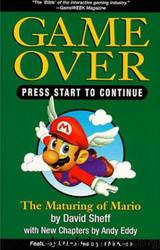Game Over: How Nintendo Conquered The World by David Sheff

Author:David Sheff [Sheff, David]
Language: eng
Format: epub
Tags: Industries, Technology & Engineering, Video & Electronic, Computers, Programming, General, Games, Electronics, Business & Economics, vl-nfcompvg
ISBN: 9780307800749
Google: b_N5FzzD3hsC
Amazon: B0060AY98I
Publisher: Vintage
Published: 2011-11-02T00:00:00+00:00
In the spring of 1987, Howard Lincoln was contacted by the first American companies that were interested in Nintendo’s licensing program. The first American licensee was formed specifically for the purpose by Greg Fischbach and Jim Scoroposki, veterans of the Atari video-game boom. The two men, who knew each other from when they worked at a games company called Activision, had laughed at Nintendo a few years earlier when they saw Arakawa and Lincoln in a minuscule booth at a trade show hawking the NES with ROB. In 1987, however, Scoroposki went to the CES convention and observed how well Nintendo was doing. It had had a healthy Christmas, and Scoroposki told Fischbach that the company just might make it. They decided to enter the Nintendo business. Scoroposki ran a sales organization that sold to toy stores on the East Coast, and with the growing number of Nintendo systems in homes and an existing shortage of good software, they felt they couldn’t lose—certainly not very much. They decided to give themselves until July of that year to see if they could make some money. They teamed up with other Activision alums, Robert Holmes (former vice-president of marketing), and, to represent them in Tokyo, Hiro Fukami. To choose a name, they picked up a thesaurus. Fischbach said it could be anything as long as it started with an A or a Z, so Scoroposki opened the book and read some words aloud. They settled on Acclaim.
The new company released its first game, “Star Voyager,” in August 1987, and one of the first 3-D games, called “Tiger-Heli,” soon after. Orders poured in, more than their most optimistic projections. “The market was absorbing anything,” Fischbach says. In the first quarter of 1988, the brand-new company made more than $1 million in profits. Acclaim grew, merging with Gamma Capital Corporation, and Fischbach and Scoroposki took it public. Analysts pushed its stock, touting it as one of the best-run video-game companies.
In 1990 Acclaim embarked on one of the most extensive campaigns of advertising, corporate sponsorship, and promotional tie-ins of all the licensees. On the back of Jell-O Pudding Pops were game tips. Free games could be won with coupons from Chips Ahoy cookies, and there were in-theater displays to promote the video-game version of “Total Recall,” the Arnold Schwarzenegger film. Acclaim began its own smaller version of Nintendo Power (mailed to only 250,000 players), and the company copublished (with Scholastic) a book based on the game “Wizards & Warriors.”
As Acclaim grew, it made a smart deal with WMS, the company that oversaw both Williams Electronics Games and Bally’s Midway. Acclaim bought the right of first refusal to make Nintendo games out of all WMS arcade titles (games such as “Narc,” which included digitized action of live actors, and “Arch Rivals,” a “basketbrawl” game). Acclaim then became the second licensee to be able to produce more than five games a year when it bought another Nintendo licensee, LJN Toys, which MCA had unloaded. LJN had strong
Download
This site does not store any files on its server. We only index and link to content provided by other sites. Please contact the content providers to delete copyright contents if any and email us, we'll remove relevant links or contents immediately.
The Mikado Method by Ola Ellnestam Daniel Brolund(20603)
Hello! Python by Anthony Briggs(19899)
Secrets of the JavaScript Ninja by John Resig Bear Bibeault(18208)
Dependency Injection in .NET by Mark Seemann(18108)
The Well-Grounded Java Developer by Benjamin J. Evans Martijn Verburg(17575)
OCA Java SE 8 Programmer I Certification Guide by Mala Gupta(17421)
Kotlin in Action by Dmitry Jemerov(17185)
Adobe Camera Raw For Digital Photographers Only by Rob Sheppard(16930)
Algorithms of the Intelligent Web by Haralambos Marmanis;Dmitry Babenko(16235)
Grails in Action by Glen Smith Peter Ledbrook(15390)
Test-Driven iOS Development with Swift 4 by Dominik Hauser(10393)
Becoming a Dynamics 365 Finance and Supply Chain Solution Architect by Brent Dawson(8055)
Microservices with Go by Alexander Shuiskov(7819)
Practical Design Patterns for Java Developers by Miroslav Wengner(7719)
Test Automation Engineering Handbook by Manikandan Sambamurthy(7671)
Angular Projects - Third Edition by Aristeidis Bampakos(7160)
The Art of Crafting User Stories by The Art of Crafting User Stories(6611)
NetSuite for Consultants - Second Edition by Peter Ries(6533)
Demystifying Cryptography with OpenSSL 3.0 by Alexei Khlebnikov(6305)
